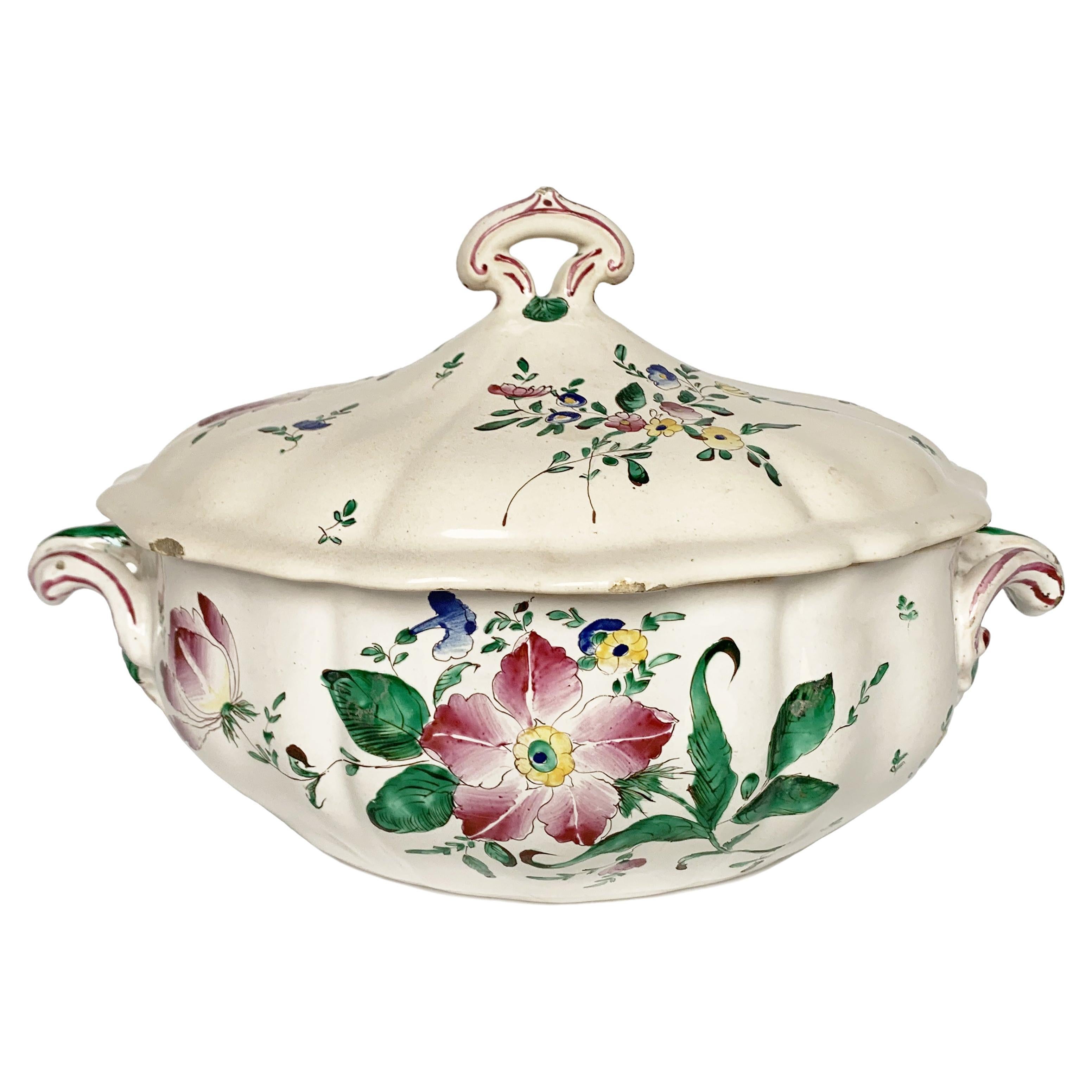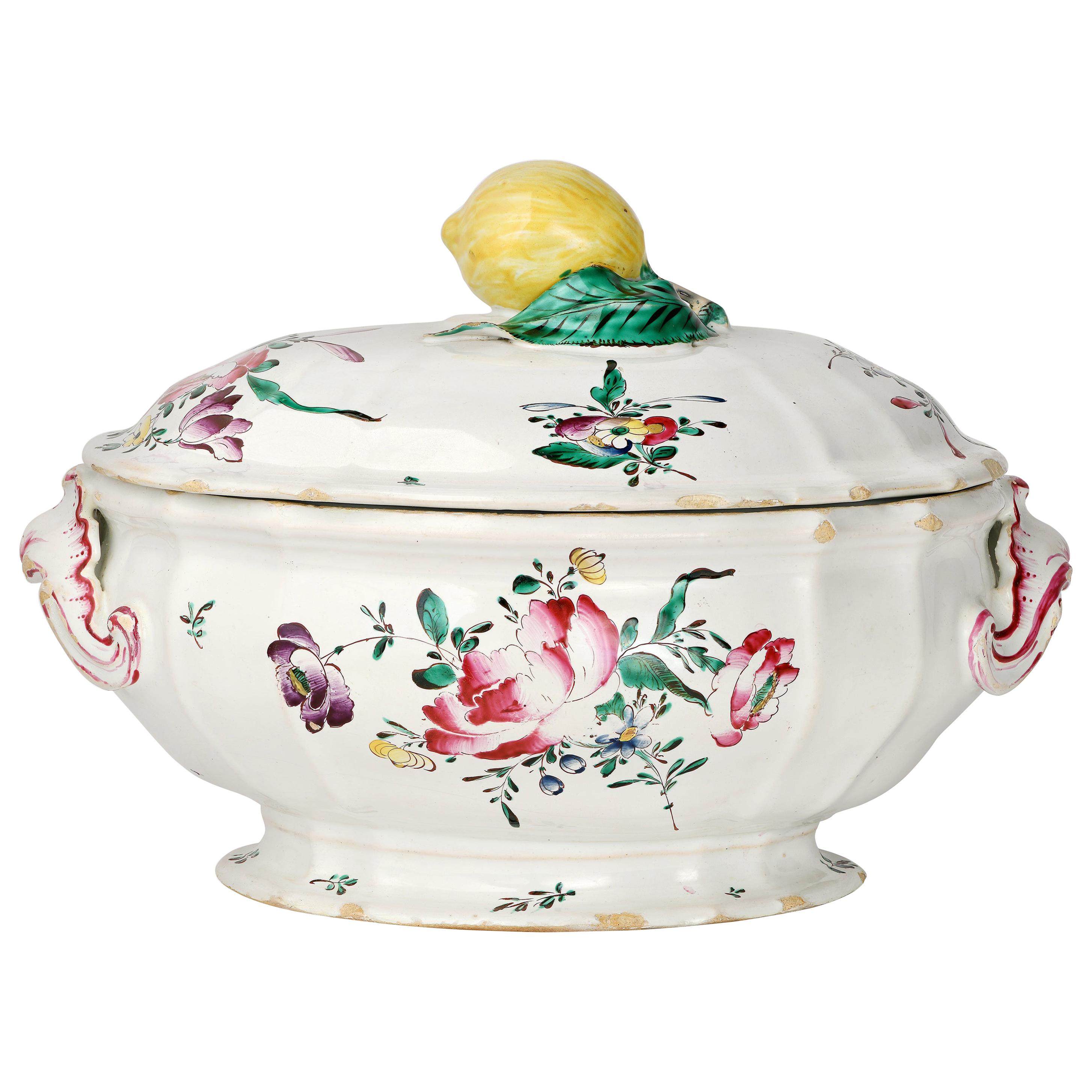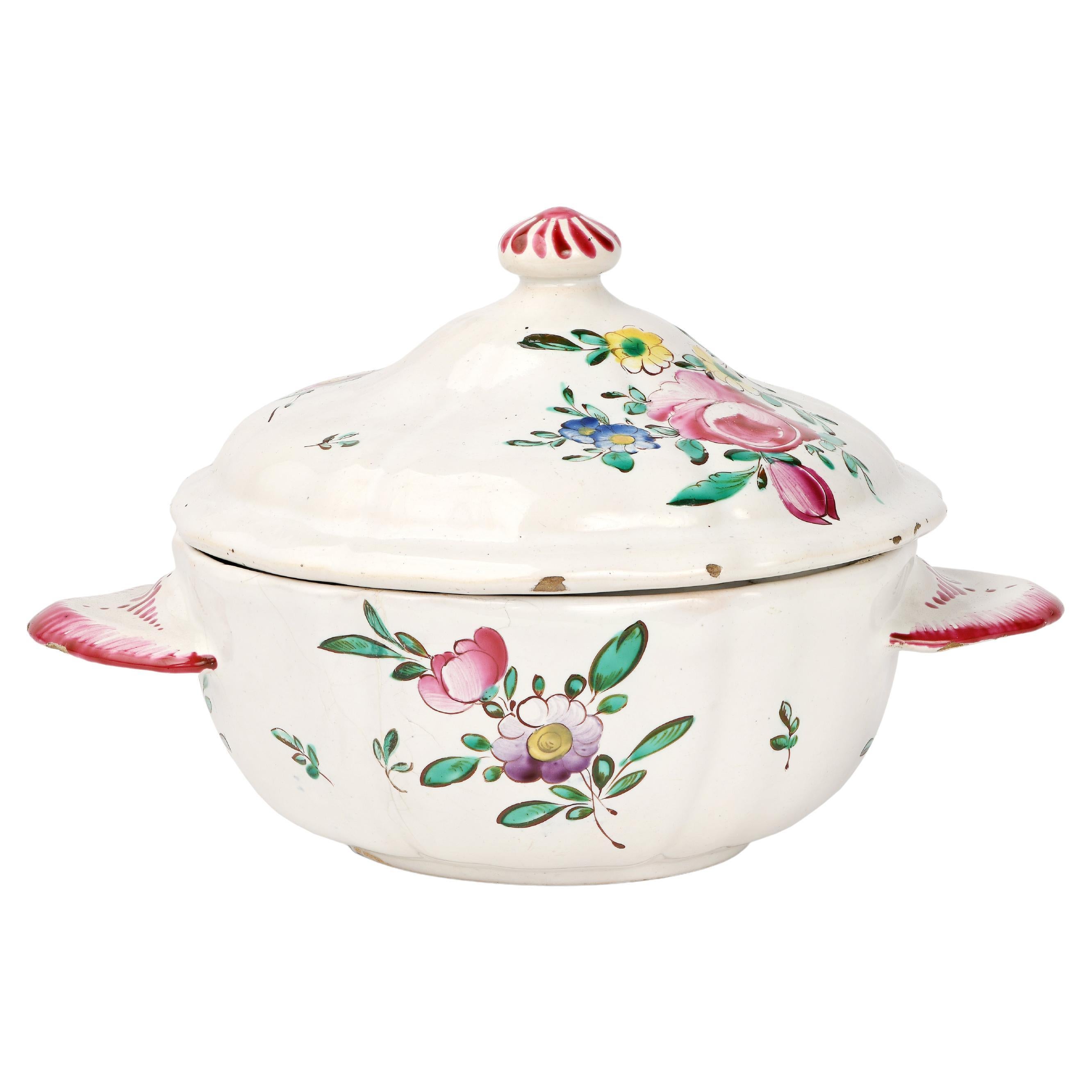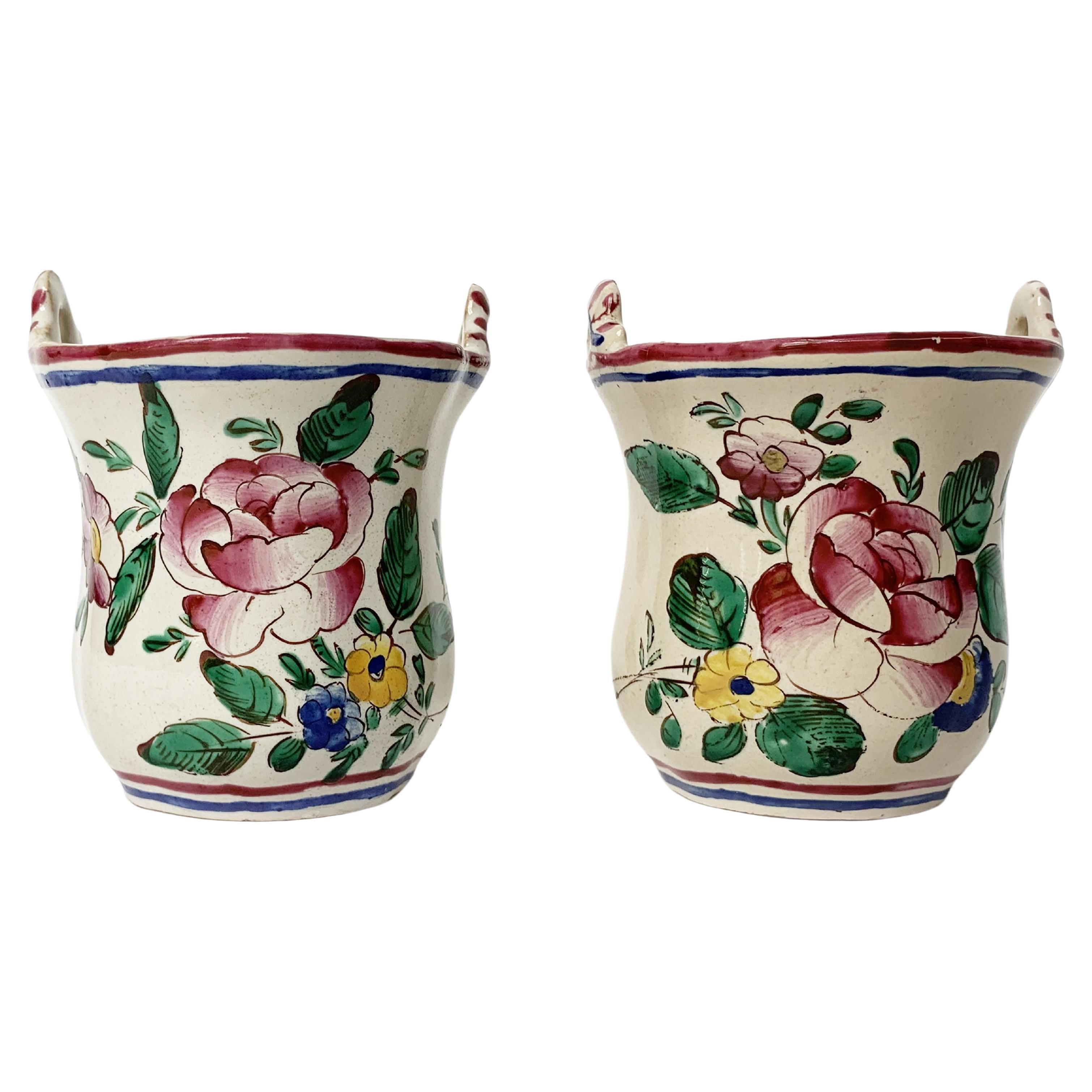Items Similar to Pair of Italian Maiolica Tureens, Ferretti Manufacture, Lodi Circa 1770 - 1780
Video Loading
Want more images or videos?
Request additional images or videos from the seller
1 of 22
Pair of Italian Maiolica Tureens, Ferretti Manufacture, Lodi Circa 1770 - 1780
About the Item
Pair of maiolica tureens
Antonio Ferretti Manufacture
Lodi, circa 1770-1780
Maiolica polychrome decorated “a piccolo fuoco” (third fire).
a – 8.66 x 11.02 x 7.48 in (22 x 28 x 19 cm)
b – 8.85 x 12.2 x 7.87 in (22,5 x 31 x 20 cm)
Weight: a – 3.27 lb (1.484 kg) e b – 3.39 lb (1.539 kg)
State of conservation:
a - some chips due to use on the edges and on the parts in relief, especially on the edge of the lid;
b - a break-through in a bend and some porous cracks on the bottom of the bowl due to use in olden times.
The two oval-shaped tureens rest on a tall, slightly flared foot and feature ribbed walls, rocailles handles and a peach-shaped lid grip. In the first bowl the handles are closer to the body, while in the other they are detached with a simpler grip. The shape of the tureens derives from a mold from Strasbourg, called “forme de Paris”.
The polychrome flower decoration shows some leafy and flowering branches with a large rose in the center and secondary flowers while a set of twigs with small flowers and "semis" of leaflets scattered over the entire surface complete the decoration. The two tureens differ from each other due to some decorative choices: the decoration on the first is more compact on the body and characterized by a wild rose with a still semi-closed corolla, whereas on the second it is more evenly spaced and the wild rose appears entirely open. The motif known as “alla rosa contornata” or “alla vecchia Lodi” constitutes one of the most loved decorations during the 18th century and is referred to in contemporary inventories as “fiori alla Strasburgo”.
This decorative choice represented a strong point of the Lodi factory, which established itself thanks to the vivid nature of the colors made possible by the introduction of a new technique perfected by Paul Hannong in Strasbourg and which Antonio Ferretti introduced in Italy. This production process, called “piccolo fuoco” (third fire), allowed the use of a greater number of colors than in the past; in particular, the purple of Cassius, a red made from gold chloride, was introduced. Its use allowed for many more tones and shades, from pink to purple.
The Ferretti family had started their maiolica manufacturing business in Lodi in 1725.
The forefather Simpliciano had started the business by purchasing an ancient furnace in 1725 and, indeed, we have evidence of the full activity of the furnaces from April of the same year (Novasconi-Ferrari-Corvi, 1964, p. 26 n. 4). Simpliciano had started a production of excellence also thanks to the ownership of clay quarries in Stradella, not far from Pavia. The production was so successful that in 1726 a decree of the Turin Chamber came to prohibit the importation of foreign ceramics, especially from Lodi, to protect internal production (G. Lise, La ceramica a Lodi, Lodi 1981, p. 59).
In its initial stages, the manufacture produced maolicas painted with the “a gran fuoco” (double fire) technique, often in turquoise monochrome, with ornamentation derived from compositional modules in vogue in Rouen in France. This was also thanks to the collaboration of painters like Giorgio Giacinto Rossetti, who placed his name on the best specimens next to the initials of the factory.
In 1748 Simpliciano made his will (Gelmini, 1995, p. 30) appointing his son Giuseppe Antonio (known as Antonio) as universal heir. After 1750, when Simpliciano passed away, Antonio was directly involved in the maiolica factory, increasing its fortunes and achieving a reputation on a European level. Particularly important was the aforementioned introduction in 1760 of the innovative “a piccolo fuoco” (third fire) processing, which, expanding the ornamental repertoire with Saxon-inspired floral themes, could commercially compete with the German porcelains that had one of its most renowned offerings in the naturalistic Deutsche Blumen. Antonio Ferretti understood and promoted this technique and this decoration, proposing it in a fresher and more corrective version, less linked to botanical tables, both with or without contour line, as well as in purple or green monochrome. After efforts to introduce more industrial production techniques to the sector succeeded, even the Ferretti manufacture, in the last decade of the eighteenth century, started heading towards decline despite its attempts to adapt production to neoclassical tastes.
In 1796 the Napoleonic battle for the conquest of the Lodi bridge over the Adda definitively compromised the furnaces. Production resumed, albeit in a rather stunted manner, until Antonio's death on 29 December 1810. (M. L. Gelmini, pp. 28-30, 38, 43 sgg., 130-136 (for Simpliciano); pp. 31 sgg., 45-47, 142-192 (for Antonio).
The tureen with newly detached handles b- was published as part of a pair in M.A. Zilocchi, scheda in R. Bossaglia, V. Terraroli, a cura di, Settecento Lombardo, Milano 1991, p. 492, V36.
Similar specimens are found in major public and private collections in Lombardy: a tureen of the same model is preserved in Milan, in the collections of Castello Sforzesco (R. Ausenda, Museo d’Arti Applicate, Le Ceramiche, Tomo II, Milano 2001, p. 217, n. 242).
Bibliography for comparison
C. Baroni, Storia delle ceramiche nel Lodigiano, in Archivio storico per la città e i comuni del circondario e della diocesi di Lodi, XXXIV (1915), pp. 118, 124, 142; XXXV (1916), pp. 5-8;
C. Baroni, La maiolica antica di Lodi, in Archivio storico lombardo, LVIII (1931), pp. 453-455;
L. Ciboldi, La maiolica lodigiana, in Archivio storico lodigiano, LXXX (1953), pp. 25 sgg.;
S. Levy, Maioliche settecentesche lombarde e venete, Milano 1962, pp. 17 sgg.;
A. Novasconi - S. Ferrari - S. Corvi, La ceramica lodigiana, Lodi 1964, ad Indicem; Maioliche di Lodi, Milano e Pavia (catal.), Milano 1964, p. 17;
O. Ferrari - G. Scavizzi, Maioliche italiane del Seicento e del Settecento, Milano 1965, pp. 26 sgg.;
G. C. Sciolla, Lodi. Museo civico, Bologna 1977, pp. 69-85 passim; G. Lise, La ceramica a Lodi, Lodi 1981;
M. Vitali, in Storia dell'arte ceramica, Bologna 1986, p. 251;
M. A. Zilocchi, in Settecento lombardo, Milano 1991, pp. 492-496;
M. L. Gelmini, in Maioliche lodigiane del '700 (cat. mostra Lodi), Milano 1995, pp. 31 ss., 45-47, 142-192;
R. Ausenda (a cura di), Musei e Gallerie di Milano. Museo d’Arti Applicate. Le ceramiche. Tomo secondo, Milano 2000, pp. 213-220;
Felice Ferrari, La ceramica di Lodi, Lodi 2003.
- Creator:Antonio Ferretti (Manufacturer)
- Dimensions:Height: 8.86 in (22.5 cm)Width: 12.21 in (31 cm)Depth: 7.88 in (20 cm)
- Sold As:Set of 2
- Style:Rococo (Of the Period)
- Materials and Techniques:Maiolica,Glazed
- Place of Origin:
- Period:1770-1779
- Date of Manufacture:circa 1770-1780
- Condition:Wear consistent with age and use. Minor losses. State of conservation: a - some chips due to use on the edges and on the parts in relief, especially on the edge of the lid; b - a break-through in a bend and some porous cracks on the bottom of the bowl due to use in olden times.
- Seller Location:Milano, IT
- Reference Number:1stDibs: LU4352220972812
About the Seller
4.3
Vetted Seller
These experienced sellers undergo a comprehensive evaluation by our team of in-house experts.
Established in 1860
1stDibs seller since 2018
19 sales on 1stDibs
Typical response time: 6 hours
Associations
International Confederation of Art and Antique Dealers' Associations
- ShippingRetrieving quote...Ships From: Milano, Italy
- Return PolicyA return for this item may be initiated within 14 days of delivery.
More From This SellerView All
- Ancient Maiolica Tureen Ferretti Manufacture, Lodi, Circa 1770 - 1780By Antonio FerrettiLocated in Milano, ITMaiolica tureen Antonio Ferretti Manufacture Lodi, Circa 1770 - 1780 Maiolica polychrome decorated “a piccolo fuoco” (third fire). It measures 9.06 in in height x 13.39 in x 9.84 i...Category
Antique 1770s Italian Rococo Soup Tureens
MaterialsMaiolica
- Italian Maiolica Ancient Tureen, Lodi, 1770-1780By Antonio FerrettiLocated in Milano, ITMaiolica tureen Antonio Ferretti Manufacture Lodi, circa 1770-1780 Maiolica polychrome decorated “a piccolo fuoco” (third fire). It measures 9.05 x 12.59 x 9.05 in (23 x 32 x 23 cm) ...Category
Antique 1770s Italian Rococo Ceramics
MaterialsMaiolica
- Maiolica Italian Pitcher Ferretti Manufacture, Lodi Circa 1770 - 1780By Antonio FerrettiLocated in Milano, ITMaiolica pitcher Antonio Ferretti Manufacture Lodi, circa 1770-1780 Maiolica polychrome decorated “a piccolo fuoco” (third fire). It measures 8.66 x 8.66 x 4.33 in (22 x 22 x 11 ...Category
Antique 1770s Italian Rococo Ceramics
MaterialsMaiolica
- Italian Maiolica Cup Ferretti Lodi, circa 1770 - 1780By Antonio FerrettiLocated in Milano, ITMaiolica puerperal cup Antonio Ferretti Manufacture Lodi, Circa 1770 - 1780 Maiolica polychrome decorated “a piccolo fuoco” (third fire). It measures: 4.3 x 6.8 x 5.3 in (11 x 17,5 x 13,5 cm) Weight: 0.78 lb (358 g) State of conservation: some closed pass-through fêlures on the cup, barely visible on the outside. Some use chips on the edge of the lid, two of which are more marked. From about the mid-sixteenth century, the puerperal soup tureen or puerperal cup became one of the most popular wedding gifts in central Italy. As an auspicious symbol, it replaced the birth table (“desco da parto”) which, on the occasion of high-ranking marriages, from the thirteenth century, had been painted by famous artists, especially in Tuscany. In France this same tureen is called "écuelle de mariée", as it is given to spouses as a sign of fertility. During the eighteenth century this custom spread even outside Italy to all social levels. Depending on availability and rank, it was made of different materials: precious metals, maiolica, porcelain, glass, pewter, etc. Beginning in the mid-twentieth century, the custom of this symbolic homage gradually disappeared, although famous designers such as Gio Ponti and Giuseppe Gariboldi, even as recently as the 1940s, revisited a model of a small puerperal soup bowl for the Ginori and, also in Italy in 1940, in a national competition for young potters, one of the themes of the test was indeed a modern model of a puerperal cup as an auspicious gift. This particular cup was also called a "service cup" or "puerperal vase" or "stuffed cup" - the windows were sealed with straw to prevent drafts of air for women in labor. In the eighteenth century the line of the puerpera cup was simplified, so much so that it took the form of a small tureen with two handles - the typical broth cup...Category
Antique 1770s Italian Rococo Ceramics
MaterialsMaiolica
- Ancient Italian Maiolica Tureen, Rubati Manufacture, Milan, circa 1770-1780By Pasquale RubatiLocated in Milano, ITMaiolica tureen Pasquale Rubati Manufacture Milan, circa 1770 - 1780 Maiolica polychrome decorated “a piccolo fuoco” (third fire). It measures 6.69 in x 11,02 x 8.26 (17 x 28 x ...Category
Antique 1770s Italian Rococo Ceramics
MaterialsMaiolica
- Small Maiolica Flower Pots, Ferretti Manufacture, Lodi, circa 1770-1780By Antonio FerrettiLocated in Milano, ITTwo maiolica flower pots Antonio Ferretti Manufacture Lodi, Circa 1770 - 1780 Maiolica polychrome decorated “a piccolo fuoco” (third fire) The...Category
Antique 1770s Italian Rococo Ceramics
MaterialsMaiolica
You May Also Like
- Majolica Goose Tureen, circa 1950Located in Austin, TXBrown Majolica goose tureen signed on underside Caugant, circa 1950.Category
Vintage 1950s French Country Soup Tureens
MaterialsCeramic
- French Majolica Rabbit Tureen circa 1940By Michel CaugantLocated in Austin, TXFrench Majolica rabbit tureen, circa 1940 signed "Caugant.".Category
Vintage 1940s French Country Soup Tureens
MaterialsCeramic
- Majolica Doe Tureen Caugant, circa 1950By Michel CaugantLocated in Austin, TXRare Majolica doe tureen signed Caugant, circa 1950.Category
Vintage 1950s French Country Soup Tureens
MaterialsCeramic
- Majolica Bison Tureen Caugant, circa 1950By Michel CaugantLocated in Austin, TXMajolica bison tureen signed Michel Caugant, circa 1950.Category
Vintage 1950s French Rustic Ceramics
MaterialsCeramic
- Vintage Italian Ceramic Swan Soup TureenLocated in Pearland, TXA lovely Italian ceramic swan floral soup tureen. Maker's mark on reverse. This gorgeous tureen is in the form of a graceful swan with beautiful h...Category
Mid-20th Century Italian Soup Tureens
MaterialsCeramic
- French Green Majolica Tureen with Grapes, circa 1890Located in Austin, TX19th Century green Majolica tureen with grapes. East of France. Measures: height / 6.5 diameter / 6" by 5"Category
Antique 1890s French Rustic Soup Tureens
MaterialsCeramic, Faience, Majolica





